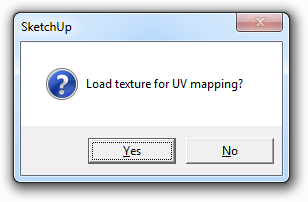Indigo for SketchUp
This is the manual for Indigo for SketchUp - the Indigo exporter for SketchUp.

Micro living concepts by sking
Installation
-
Download and install Indigo
Download Indigo RT or Indigo Renderer for your system and install to the default location on your system.
You can download Indigo from here: http://www.indigorenderer.com/download/ -
Download and install Indigo for SketchUp (SkIndigo)
On Windows, the Indigo installer comes bundled with the latest version of SkIndigo, the installer for which should launch from the main Indigo installer.
Mac users must download the RBZ file and install it manually (since there is no installer for those platforms); the latest version of SkIndigo can be downloaded from http://www.indigorenderer.com/documentation/sketchup.
Please see https://www.indigorenderer.com/documentation/manual/indigo-sketchup/inst... for instructors on how to install the RBZ file.
-
Check your SkIndigo Installation
Restart SketchUp after installing SkIndigo and you should see see “SkIndigo” become available under the Plugins menu.

The SkIndigo Plugins menuYou are now ready to use SkIndigo.
-
Enabling the SkIndigo toolbar
The SkIndigo toolbar should be enabled by default, however if it is closed, you can re-enable it by right clicking on the toolbar area, and ticking SkIndigo from the context menu.

The SkIndigo toolbar should now be visible:
-
Getting help with SkIndigo Installation
If you have any issues installing SkIndigo, please email us at support@indigorenderer.com.
Installing SkIndigo from a RBZ file
The Indigo for SketchUp (SkIndigo) extension is available in the standard .rbz format for SketchUp extensions. These steps will describe how to install the extension.
-
Download and install Indigo
Make sure you have Indigo Renderer or Indigo RT installed first.
Download Indigo for your system and install Indigo to the default location on your system.
You can download Indigo from here:
http://www.indigorenderer.com/download/ -
Download the SkIndigo .rbz file
If you haven't already, download the SkIndigo rbz file from the SkIndigo page
-
Install the .rbz File
Start SketchUp.
For SketchUp 2017 or later, select Windows > Extension Manager.
For SketchUp 2016 or earlier,
On Mac, select SketchUp > Preferences.
On Windows, select Windows > Preferences.Select the Extensions item on the left of the Preferences dialog.
Click on the Install Extension... button.
Select the SkIndigo-3.x.x.rbz file you just downloaded.
Click the Open button.
Click the Yes button in the 'Do you trust this Extension' dialog.
Restart SketchUp.
-
Check your installation
Once you have restarted SketchUp, SkIndigo should be installed and available to use.
You can check it by selecting Plugins > SkIndigo > Render Scene
The Plugins Menu
The Plugins Menu is the primary place to access SkIndigo functionality, open dialogues and start rendering.

| Render Scene | This exports the scene to an Indigo Scene File and launches Indigo to start Rendering. |
| Export Scene as... | Exports the current scene as an Indigo Scene File and prompts you to choose a location to save to on your computer. This is handy if you want to send a scene file to someone else, or upload it to a render-farm. |
| Export Sketchy Replay Animation | Exports an animation generated by Sketch Replay. You should get the latest version of SketchyPhysics (a plugin by Chris Phillips) to use this feature. For every object that you wish to animate, you must right click and 'Enable Instancing' for that Group or Component. |
| Export Scene Tab Animation | Exports each scene tab as a separate frame in an animation. Creates Indigo Scene files for every frame and saves a batch file that progresses through them. Must have Halt (Render settings > Advanced) set to stop the rendering frame after a certain amount of seconds, or samples per pixel has been reached. |
| Render Settings | Opens the Render Settings window for configuring the Indigo export. |
| Material Editor | Opens the Material Editor window for creating and modifying Indigo materials inside SketchUp. |
| Query Material Types | Pops up a dialogue with all of the Indigo Materials in the current scene and the types of each material. Also useful for checking which material are emitters. |
| Set Light Layer Names | Specify names for the Light Layers. Useful for later reference. |
| Set Indigo Path | If SkIndigo does not find Indigo in the default folder, then you can specify its location here. |
Toolbar
After SkIndigo has been installed, a small toolbar is added to the SketchUp user interface for easy access to commonly used export functionality from the menu:

Render with Indigo |
Export the SketchUp scene to Indigo format and start rendering it in Indigo. |
Render Selected Entities |
Export and start rendering only the currently selected entities in your SketchUp scene. |
Material Editor |
Open the SkIndigo material editor. |
Render Settings |
Open the SkIndigo render settings dialog. |
Right-Click Menu
SkIndigo adds some features to the context-sensitive right-click menu in SketchUp.
Instancing
Instancing is a feature which allows many instances (or copies) of a mesh to be represented in the scene, while only actually storing the mesh once (thereby saving a lot of memory compared to straight-forward duplication).
There are two ways this can be achieved in SkIndigo:
-
Proxy Instancing
A proxy is a reference object that references a more complex object with a usually simpler copy, in order to keep the overall scene geometry low, while allowing the render geometry to stay high.
- Create the object you wish to copy, create a component out of it (right click, select 'Make Component') and name it “objectname”
- Create a new object to use as a proxy (a cube will do) and create a component out of it named “objectname_dummy”. It is important that it has the name of the original component followed by “_dummy”
- Copy and manipulate these dummies around the scene and on render they will be replaced by the original component.
-
Component Instancing
Copies of components in SketchUp will export using Indigo instances.
- Create the object you wish to copy, create a component out of it (right click, select 'Make Component'), with any name
- Copy and paste the component object.
Component copies will be exported as Indigo instances - each component copy will only use a small amount of memory.
UV Mapping
UV mapping is the process of modifying the texture map to fit the model. SkIndigo supports 4 UV maps per mesh face, which means you can have a the texture map aligned one way, the bump a different way, and the clip map another way on every surface in your scene.

SketchUp has a basic UV positioning function that is used to manipulate the textures. It is also very important that the faces are facing the correct direction, if the UV mapping function is not listed in the Right-click SkIndigo menu, then try reversing the faces.
- Here is an example run-through on how to set a textured object with a differently positioned bump map
- Set the desired bump map as the albedo for positioning purposes.
- Set the bump map position with the SketchUp tools (Rightclick > Texture > Position)
- Rightclick > SkIndigo UV Mapping > Save UVs to set 2
- Change the albedo to the actual albedo and the the bump to the bump.
- Position the Albedo with the texture tools and save it as UV set 1.

Selecting the UV set in the texture editor - In the SkIndigo Material editor, open the Texture Editor for the albedo and change the UV Set to 1. Set the bump map's UV Set to 2.
- Now it will use different texture positions for the albedo and bump map. Render to test.
Material Editor
This is where you can add the unique Indigo material settings to your objects so they behave realistically. You can find it via: Plugins -> SkIndigo Material Editor. See Indigo Materials for full information.

To work with an Indigo material, simply open up the SkIndigo Material Editor and apply any SketchUp material to an object. The painted material will be selected in the SkIndigo Material Editor. There are other ways to select a material for the SkIndigo Material Editor:
- Use "pick" from the SkIndigo Material Editor
- Select a face and in the right-click context-menu select the name of the material
-
List of Materials
Here is where all the textures applied in your SketchUp scene are listed, choose the desired one to start creating a material out of it.
-
Main Menu
Import Import a Indigo Material (.IGM). Use to bring in materials from the Material Editor. Export Export this material as an IGM or PIGM file which can be opened in the Indigo Material Editor or uploaded to the Indigo Material Database. UI This switches between the simple mode of SkIndigo, and the normal mode (See above). The simple view takes your settings and converts them as best as it can to normal settings. Normal mode is recommended. It is well worth your time to learn the Indigo Material Types as it allows you full control. Search Search the online database and download materials Pick Use a picker tool to select materials -
Preview Pane
Shows the current material, the Preview function replaces this with a rendered scene with the material placed on the chosen model (to the right). Make sure you stop the preview when you are finished previewing the material as this can greatly slow down your computer.
-
Material Type
Select the Material Types from this drop-down list. Each has its own attributes that are listed below. Assign Preset: Choose a preset material from the list provided. This will replace any of the current material settings. See Material Types.
-
Material Attributes
Here is where the material attributes live. They allow you to add more details to your material. The list will change depending on the Material Type selected. See Material Attributes.

-
List of Material Attributes
-
Map
Where the information is sourced from. Depending on which map type is selected, the "..." on the right will open different editors.
Constant A constant value. SketchUp Use the SketchUp texture or color. Texture Use an external (non-SketchUp) texture map. Shader Define a material using the Indigo Shader Language (ISL) -
Values
Changes the common value of this attribute. Usually a multiplier.
-
Map Editor
There are several editors that will open depending on the map set.
-
SkIndigo Texture Editor

Position Map: First, select any number of faces in your model. Clicking this button will apply this texture to the selected faces so you can then position the texture using the SketchUp texture positioning tools. Once you have positioned the texture, you can save the UV set using the right-click context menu. Be sure to paint the desired material back to the selected faces before rendering.See Texture Maps
-
-
-
Emitter Attributes
See Base Emission and Emission
-
Media Attributes
See Internal Medium
-
Mesh Subdivision
See Subdivision
Render Settings
The Render Settings Window configures the scene for export to Indigo.
Find it at Plugins > SkIndigo > Render Settings

| Apply to model | Apply the settings to the current scene. |
| Apply to Scene | When you select the scene, the settings will be loaded and used for rendering. |
| Reset Camera | Resets any changes to the camera. |
| Save Defaults | Saves all current render settings as default starting settings. |
-
Output
Image Dimensions Configures the width and height of the render to be created. Keep in mind that the free version of Indigo can only render images up to 1000x700 pixels in size; you will need to order a licence to use higher resolutions. Region Rendering Region rendering allows you to render only a small part of the scene. This is similar to moving the camera, but is useful when you need to focus the render on a part of the full image. Save to .IGI Saves an IGI file for reach rendered scene. On by default. Custom Image Name Enable this to use a custom name for the PNG image that is automatically saved when rendering. Watermark Enable this to add the Indigo logo to the rendered image. The free version of Indigo will always do this, regardless of this setting. Image Name To use this image name, the Custom Image Name checkbox must be checked. Image Path Renders will be auto-saved to this directory. Thumbnail Path Material preview images will be saved to this directory. Auto-Save Period Enter the time interval in seconds that the rendered image will be saved. -
Camera
See Camera
-
Tonemapping
See Tonemapping
-
Environment
See Environment
-
Advanced
Clay Mode
If the SketchUp Face Style is set to Monochrome, SkIndigo will export the scene in Clay mode.
This is where all the materials are replaced with a grey diffuse material. This can be helpful for checking geometry and lighting without being distracted by materials.
To enable clay mode, Go to the View menu in SketchUp, then select Face Style > MonoChrome

Clay mode disabled

Clay mode enabled
SkIndigo Tutorial
This tutorial goes over generating a simple scene and lighting it a few different ways. The scene will be a typical German apartment with white walls, wood flooring and some furniture from Ikea. We won't be modelling the garage with an Audi, dog called Schatzi and traditional lederhosen.
This tutorial was done for SketchUp 2013 free version; your SketchUp may look slightly different, and basic familiarity with SketchUp (e.g. navigation and selection) is assumed.
Step 1. Create the basic room
First up we will model the room. Start by drawing a rectangle on the ground and another rectangle just inside it. Your rectangle should be 12 metres by 12 metres, look at the dimensions box in the bottom right of your window to see the size as you drag the box out.
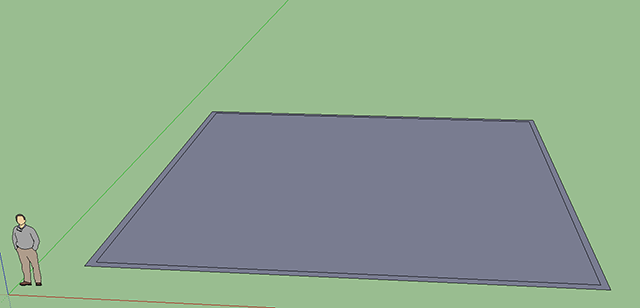
The ground plan of our room
Use the push/pull tool to make the walls 3.5 metres high. We won't put a roof on the box just yet so that we can see inside it. The next step is to put a big floor-to-ceiling window at the front of our box: use the rectangle tool to draw a rectangle on the front of the box, then use the push / pool tool to push the new rectangle inwards until the wall is paper thin.
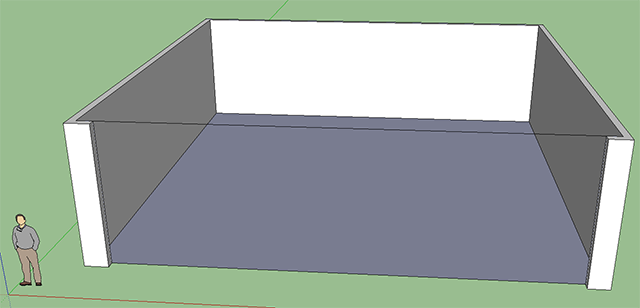
Our room with a paper thin front wall.
Now click on the paper thin wall and delete it. Don't delete the line at the top of your room, we'll need that in a second. Now press Plugins → SkIndigo → Render Scene and you will get a render like this:
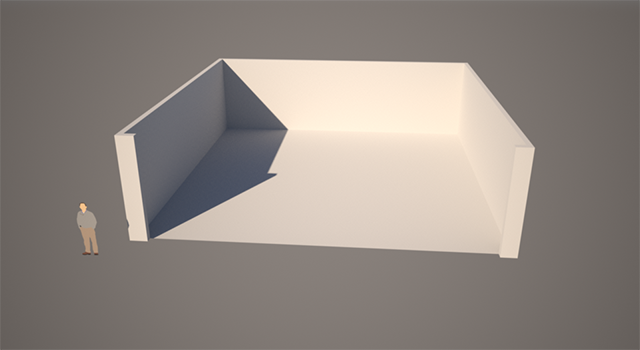
Derrick standing outside his new house, in free space.
Step 2. Add window and roof
For the next step, we will add a roof and a window and set a wooden texture on the floor and a glass window. Start by using the rectangle tool to enclose the roof. Then draw a rectangle on the wall of the left hand side and use the push / pull tool to push the rectangle through to the inside. Delete the paper thin wall that is left and you should have a window hole like so:
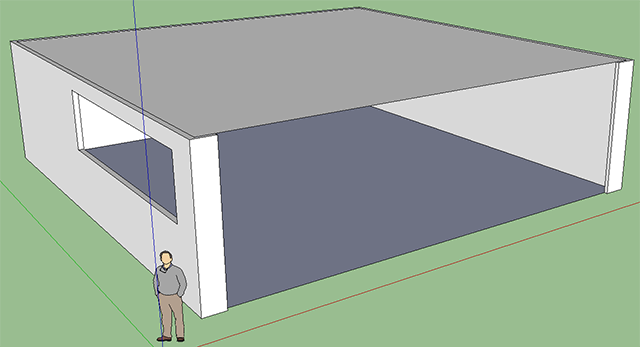
Our box room with a window and a roof.
As a final step, use the Move tool to put Derrick somewhere side the house.
Step 3. Paint a wood texture on the floor
Next, press the Paint Bucket tool and the SketchUp materials dialog will open. Select wood from the selection box:

Now choose wood_floor_light as a texture. Then click on the floor. Your floor will now be textured, however to get a more realistic appearance for a varnished floor, we need to change the material type to Phong.
To do this, we first open up the SkIndigo Material Editor from the SkIndigo toolbar:
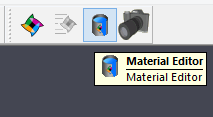
With the material open in the SkIndigo Material Editor, change the material type to Phong:

Zoom in the camera a little and hit render – your house should look like this:

Derrick in his new house with a roof, window and a floor.
Now right click on the floor and select Texture → Position. Rotate the wood texture 90”. You can also scale the wood texture if you want.
Step 4. Add some carpet
Carpet is a tricky thing to model because it has so many individual fibres. The best way of creating a carpet in SkIndigo is to use what is called a displacement map.
Start by drawing a rectangle on the floor and using push/pull to make it into a box of 3cm height. Then use the select tool Edit → Make Group.
When we add a displacement map, it will make our "carpet box" very bumpy, which means the edges of the box won't line up. To prevent gaps appearing, right click on the carpet and select Soften / Smooth Edges, choose a value of 90 degrees between normals and press enter.
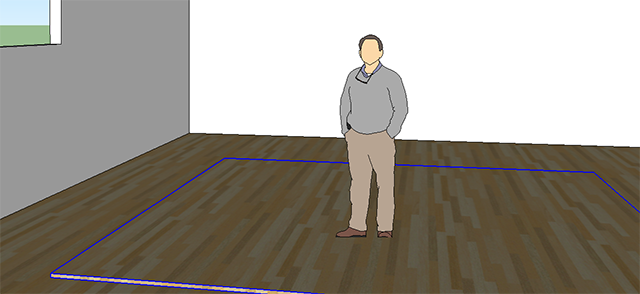
Our carpet box ready to texture map.
Next, using the paintbrush tool, select the Carpets and Textiles set and the Carpet_Plush_Charcoal texture. Apply it to the carpet box. Right click on the carpet box and choose SkIndigo → Edit [Carpet_Plush_Charcoal]. The SkIndigo Material Editor will open:
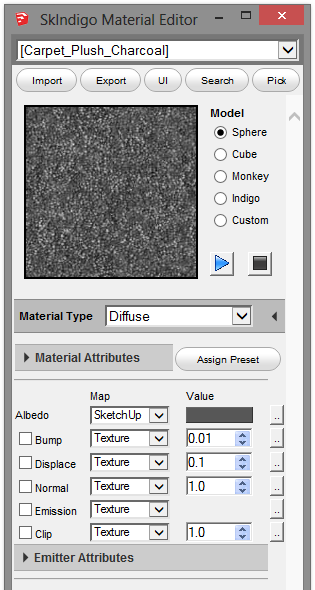
SketchUp material editor
Note that the Albedo channel (which means the color of the material) is already set to the SketchUp carpet texture.
Now, change the displacement map to "SketchUp" which will tell SkIndigo to use the current SketchUp texture as the displacement map. Then change the value to 0.05 which will give a maximum displacement of 0.05 meters where the map pixel value is pure white. Be sure to enable displacement mapping by clicking on the checkbox.
Press Plugins → Skindigo → Render Scene, you may note that the carpet looks all triangulated and bumpy. You may need to increase the "detail" of the carpet by adding more subdivisions. Right-click the group and, from the Edit Active Mesh dialog, increase Max Subdivisions to at least 9. Also, uncheck the box for "View Dependent". This setting will decrease the amount of subdivision for geometry that is farther away from the camera, but we'll leave this optimisation for now.
Render the scene again.
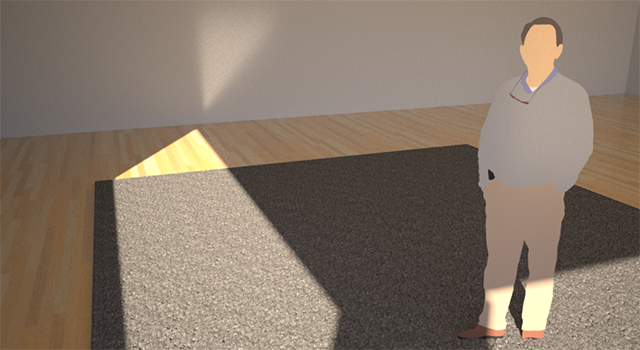
Derrick admires his nice grey carpet.
Step 5. Add a chair and lamp
Use Windows → Components menu to show the components window. Search for Barcelona chair and insert one into the scene. Then search for Kare 5701 (a lamp) and insert it into the scene too.
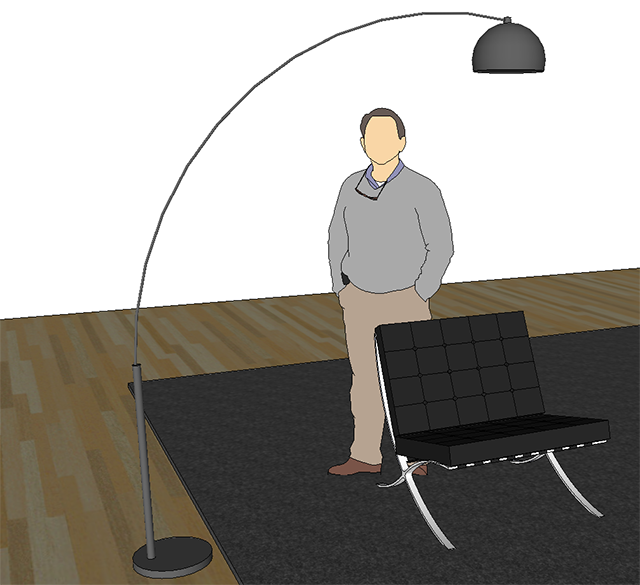
Scene with a lamp and chair added.
In the Material Window click New Material to create a new material. Name this material "Chrome" and apply it to all of the surfaces of the lamp (Use SkIndigo → Edit [Chrome]). Then, in the SkIndigo Material Editor, change the material type to Metals, and select the Chrome preset from the dropdown box.
If you now render the scene, it should look like this:

Lamp has a shiny material applied.
Step 6. Adding nighttime lighting
Now we will try adding a lightbulb inside the lamp and taking a night scene. Start by turning off the sun by going to Plugins → SkIndigo → Render Settings, then Environment. Select SketchUp background color and make sure Black is selected like so:
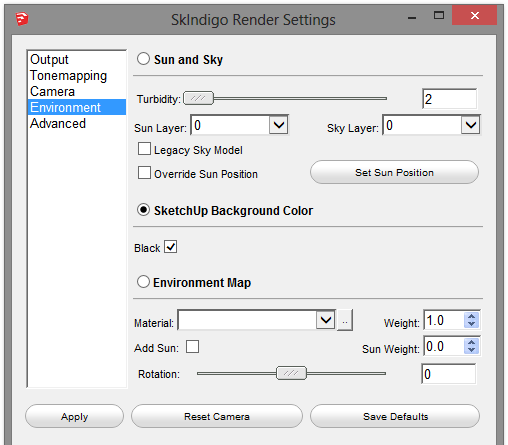
Now we need to add a light inside the lamp. Double click the lamp to edit it, then look inside the lampshade and create or select the lighbulb inside it (your lamp may look slightly different, you may have to create the lightbulb yourself).
Create a new material called Lightbulb, then right click on the bulb SkIndigo → Edit [Lightbulb] material, then set the Albedo to be a constant black (since we don't want the lightbulb itself to reflect light), and set the Emission layer to 0 in the Emission section of the material editor.
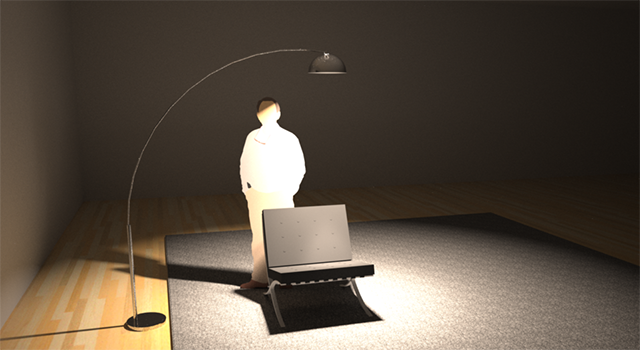
Our house illuminated from a single 5000K emitter.
Step 7. Finetuning
The trick to getting really realistic renders from SketchUp + Indigo is to spend time tweaking your materials until they look just right. In this example we used models from the Google Warehouse that are relatively low in polygon count, so don't look ultra realistic, but by carefully editing the materials used on the models you can make the scene look better and better.
One of the advantages of Indigo is that if you set a 100 Watt lightbulb in a lamp, you can see how the light will fall off around the room, useful for doing lighting analysis – will you need more light fittings in the corner of the room?
To increase the realism of this scene, you could:
- Increase the Mesh Subdivision of the carpet to 10. This will make the carpet seem finer grained and more "fluffy".
- Add a bump map to the floor material, of height 0.1 centimetres, to simulate the grain of the wood.
- Reduce the "exponent" of the chrome material to make the floor lamp less reflective.
As you can see there are many options that you can tweak to get the best possible results out of Indigo.
Creating ultra realistic scenes that look like something from the real world is usually achieved by recreating all of the models in the scene with accurate geometry, and then spending 30-40% of your time modifying materials in the scene to ensure that they are as realistic as you would like them to be.
We hope you have enjoyed this brief introduction to SkIndigo.
Materials
Texture Scaling
Often you will need to change how rapidly a texture or material is repeated over a surface. This is referred to as texture scaling, or sometimes as UV-scaling.
Suppose you have a material where the texture is too 'stretched-out'.

We can fix this by changing the texture scaling.
In SketchUp, show the material dialog with Window -> Materials.
Select the material you wish to scale with the picker tool. In our case we will select the wood material on the ground object.
Click on the 'Edit' tab.
In the 'Texture' section, change the horizontal width to a smaller value, such as 0.3 m.

The texture should now repeat more rapidly over the surface, in SketchUp and in Indigo as well, when the scene is exported again.

Procedural Materials
The same technique can be used for procedural materials, which may not use a texture map. In this case, you can use a 'dummy' texture, by clicking 'Use texture image' in the Materials edit tab, and then selecting a dummy texture. The dummy texture will be displayed in the SketchUp viewport, but will not affect the Indigo render.
SkIndigo on Windows Tutorial
This tutorial will cover getting Indigo running with Google SketchUp on your computer running Microsoft Windows. We will use the SkIndigo exporter to export scenes from SketchUp to Indigo.
You can use either the free or the commercially licensed Indigo version to follow this tutorial; the free version will add a watermark to the final renders and limit the resolution to 0.7 megapixels.
Step 1: Install SketchUp
If you already have SketchUp installed, you can skip this step.
Download and install SketchUp from here: http://www.sketchup.com/intl/en/download/
Step 2: Download Indigo Renderer
The latest version of Indigo Renderer can be downloaded from this page: http://www.indigorenderer.com/download-indigo-renderer
If you have a 32-bit operating system, or you are not sure, download Indigo Renderer for Windows 32-bit.
If you have a 64-bit operating system, download Indigo Renderer for Windows 64-bit.
Step 3: Install Indigo Renderer
Once you have downloaded the Indigo installer program in Step 2, run the installer program.
If the installer asks you 'Do you want to allow the following program to make changes to this computer,' select 'Yes.' Please carefully read the licence agreement, then click 'I Agree.'
On the 'Choose Components' page, leave all components selected, and press 'Next >'
On the 'Choose Install Location' page, leave the Destination Folder as it is, and press 'Install.'
Press 'Finish'. Indigo will open after installation; close it for now, since we'll be using it via SkIndigo.
Step 4: Open Sketchup
You should now see the new SkIndigo tool bar:

Step 5: Enable extension in SketchUp 2016
In SketchUp 2016 you may need to enable the extension in the preferences.
Select Window > Preferences from the main menu.
Under Extensions, enable SkIndigo.
Step 6: Render with Indigo
Press the 'Render with Indigo' button in the SkIndigo tool bar:

If everything has been installed successfully, Indigo should launch, and start rendering the default scene immediately:

Tutorials
Modelling a pool in SketchUp
Introduction
In this tutorial I will show how to model a simple swimming pool in SketchUp and Indigo, with nice caustics at the bottom of the pool. This is what we will be making:

Model the pool ground and walls
Create a quad like so:
Create a rectangle in the middle of the quad:
Using the Push/Pull tool, push the middle down to create the pool recess:
Create the water volume
Create a cuboidal volume for the pool water. It needs to be somewhat larger than the pool recess along all axes.
Create the water material
Create a new SketchUp material called 'water' or similar.
Set the opacity to something around 50% to make sure the water material is transparent.
Apply the material to all faces of the water volume.
Move the water volume into place
Move the water volume into place with the move tool. The sides of the water volume should extend past the pool recess like so:
Finishing the water material
We need to set a couple of settings in the water material - some absorption to give the water a blue/green tint, and some displacement, to create the water ripples.
Open the SkIndigo material editor, and make sure the 'water' material is selected.
Change the material type to 'specular':
Change the Absorption type to 'none'.
Click the dotted button to the right of 'Absorption'.
Set the RGB absorption to R: 0.2, G: 0.12, B: 0.1:
Now we need to create the displacement shader.
Check the 'Displace' checkbox in the SkIndigo material editor,and set the type to 'Shader'.
Now click on the dotted button to the right of 'Displace'.
Paste the following shader code in to the shader editor:
def eval() real :
fbm(posOS() * 2.0, 2) * 0.02
Like so:
What this shader does is displace the water surface by up to 2 cm (0.02 m), based on some pseudo-random noise (fbm) based on the object-space position (posOS).
If you want to make the ripples higher, you an increase the 0.02 number.
If you want to make the ripples more closely spaced, you can increase the 2.0 number.
Setting subdivision on the water volume
We want to make sure that only the water volume mesh gets subdivided.
To do this, first make sure the entire water volume object is fully selected by triple-clicking on it:
Now right click on it, and choose 'Make Group'.
Now double-click on the group to select it. This should grey everything else out:
Now right click on the pool volume and choose 'Edit Active Mesh' from near the bottom of the menu. It should say something like 'Group#1 (6 faces)' at the top of the SkIndigo Mesh Settings dialog.
Set 'Max Subdivisions' to 8. This will turn each original quad face into 4^8 = 65536 subdivided faces.
Also un-check the 'View Dependent' checkbox, and set 'Curvature Threshold' to zero:
Make the final render
First off, we have to change the render mode to Bidirectional with MLT:
This is very important as it's the most efficient mode for rendering these kind of caustics.
Position the camera above the pool, then press the 'Render in Indigo' button.
After a while, you should get an image like this:

You may have to be a little patient waiting for the render - even with bidirectional MLT, it can still take a while.
Setting up interior lights mixed with sun+sky lighting
We will start with a kitchen scene, downloaded from the SketchUp 3d Warehouse, with some walls added:
By default this will render in Indigo with Sun+sky illumination, resulting in a render like this:

We now want to set up the lights hanging above the bench so they emit enough light to be visible.
First off, we want to add a quad in each light fixture which will emit the light.
A single quad results in the most efficient rendering. The quad should not be too small (otherwise it will make specular reflections noisier). It is also important that the front side of the quad is pointing down - as in Indigo by default, light is emitted from the front side of a surface only.
The next step is to create a new SketchUp material. I have called mine 'light mat'. Since I have the SkIndigo material editor open (you can open the SkIndigo material editor from the SkIndigo toolbar) it shows and allows me to edit the 'light mat'. You will also want to assign the your new material to the new quads you have created.
The next step is to edit your new material so it emits light.
You can do this by expanding the Emitter Attributes section, then setting the Layer to something like 1,
and setting the Emission Scale to something like 100000 lm.
Note that the emission scale needs to be very high for the light to be easily visible in daylight.
And that's all there is to it!
Since we put the interior lights on light layer 1, we can use the light layer controls in Indigo to view the contribution of the interior lights separately from the sun+sky lighting (see the layer thumbnails on the right):
Using exit portals in SketchUp
Introduction
Exit portals (often abbreviated as EP) are a way for artists to assist the rendering engine in difficult lighting situations, by specifying a "portal" through which light will travel. These are very useful for interior renders, where there is a relatively small opening letting in a lot of light (such as a window) that is not easily accessed - in such scenes, there is often a dramatic increase in convergence speed (since light-carrying paths are much more easily constructed).
In the example below both images rendered for 5 minutes, the only difference being the presence or absence of exit portals (click to enlarge):
Requirements and limitations
There are several requirements for exit portals to work effectively:
- All openings through which light can "escape" (directly to the background or environment) must be covered with exit portals.
- The exit portal normals must point inwards.
- Bi-directional path tracing mode must be used.
Finally, note that nothing gets rendered behind an exit portal: when a light ray strikes the portal it is assumed to immediately "exit" or escape to the background / environment, without considering any other objects in the scene.
Modelling with exit portals
We now show how to convert a simply modelled room with an opening into a scene using exit portals in SketchUp. The scene below shows an interior space, illuminated only by two openings which allow sunlight in:

Next we create quads to cover the openings, corner to corner. There should be no gaps, and to really make sure this is the case it could be made slightly bigger than the opening and fitted inside to slightly intersect the surrounding geometry.
The next step is crucial to stop these quads being part of the surrounding geometry (and therefore sharing its material settings): select the quads to become exit portals, right click on them, and make them a group. You should see them marked as a blue group:
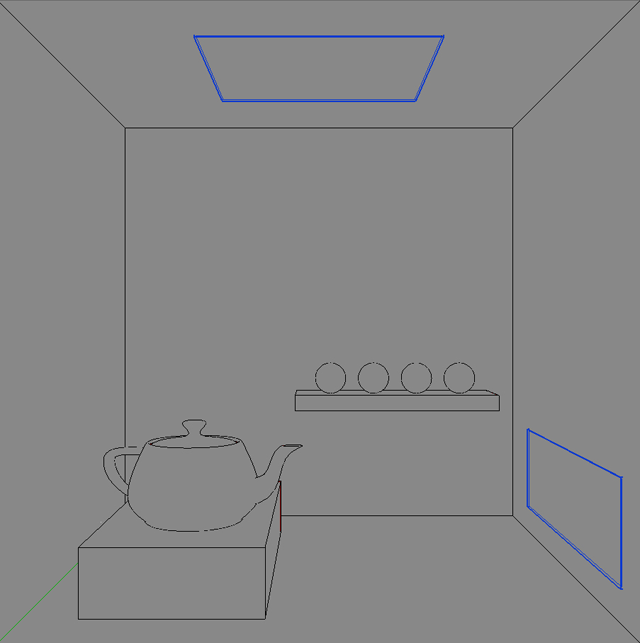
To turn them into exit portals, simply use the exit portal material type for the object.
With the exit portal created, we can now export to Indigo and enjoy the much faster convergence.
If Indigo reports an error such as "Error: Scene parsing error: Model (UID 42) has a different number of materials than geometry material references", it means that the exit portal quad was merged with the surrounding objects. This won't work because we need only the quad to be flagged as an exit portal.
Make sure that the front face of your exit portal object is pointing inwards into the scene!
You may need to flip the group along an axis to achieve this.
Thanks to Filippo Scarso / Pibuz for the example scene and helpful suggestions.
Using orthographic cameras with SketchUp
Introduction
Orthographic cameras remove the perspective effects normally seen in a 3D rendered image. This is sometimes desirable for technical illustration or architectural visualisation purposes.
In this tutorial we'll cover the steps required to render with orthographic cameras in SketchUp, as well as cover some potential pitfalls with their use.
Switching from perspective to parallel projection
We start with the normal (perspective projection) camera, which will give the normal depth cues such as distant objects being smaller, in a simple scene with some boxes:
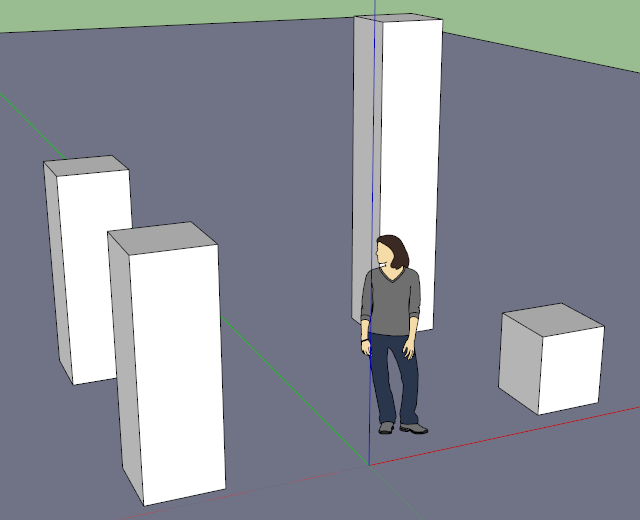
We now select the Parallel Projection option from the Camera menu, which will enable the orthographic camera mode:
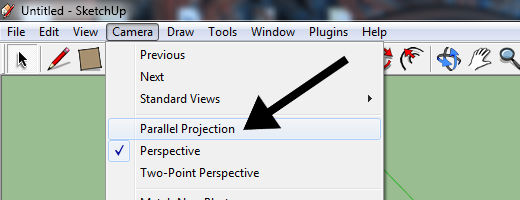
With this applied, we can immediately see the viewport change to remove all perspective effects.
The zoom level may need adjusting to keep the same part of the scene in view; bear in mind that this is actually changing the camera's sensor size, so if you're rendering a building it will need a building-sized camera.
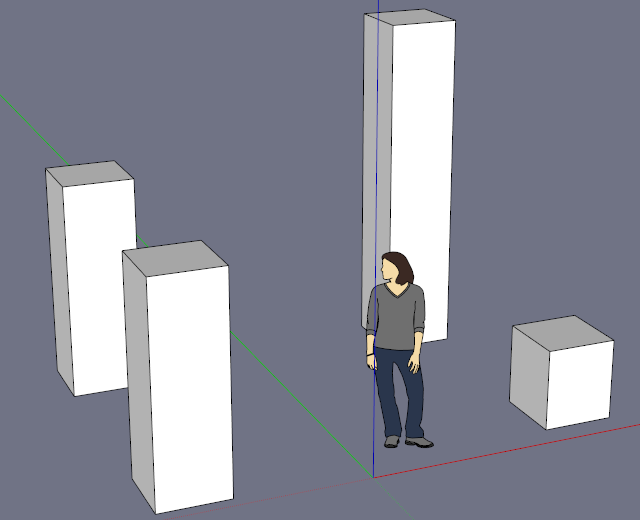
Pitfalls
Orthographic cameras require Indigo 3.4.4 or newer; earlier versions will report an error when attempting to render scenes which have a non-perspective camera defined.
The orthographic camera must be at least as large as the objects in view, since they are directly projected (parallel rays) without any perspective effects which might otherwise allow large objects in the distance to be viewed with a much smaller sensor.
One potential pitfall with large camera sensors is that they may intersect other scene geometry (e.g. go through walls), especially different media (e.g. go through glass or water), causing problems.
The former will result in open spaces between surfaces, which may or may not receive light, while the latter can be more problematic; Indigo currently (as of 3.4.8) assumes that the camera is in a single medium, which is usually a reasonable assumption, however with the large sensors sometimes used in orthographic rendering, this assumption is more likely to break down.
Using section planes in SketchUp
Introduction
Section planes allow you to create "cut-away" renders of scenes without having to change the (potentially complex) underlying geometry, using oriented planes to slice away obstructing sections from view. This is related to cut-away diagrams classically used in technical illustration.
In this tutorial we'll cover using SketchUp's section planes with Indigo version 3.4 or newer.
Adding and enabling sections
The first thing we'll need to do is enable the Sections toolbar if it is not already enabled; this can be done via the "View" menu, under "Toolbars" -> "Sections":

With these controls available, we can now add a section plane using the first tool on the toolbar (Section Plane):

Once the plane has been placed and oriented as desired, we must right-click on it and select "Enable Section Plane" from the SkIndigo sub-menu:

If we now render the scene with Indigo, we see that the section to the front of the section plane is rendered, and the rest has been clipped away:
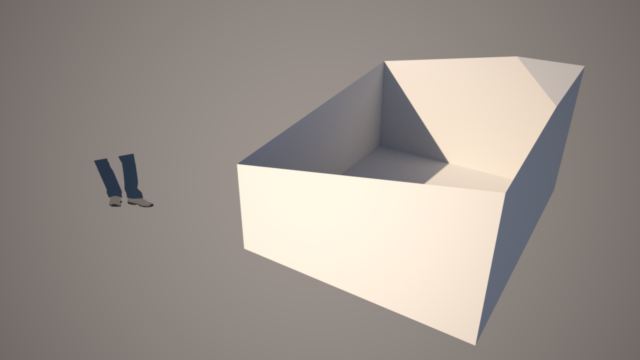
Multiple section planes can be used together in this manner, to cut away whichever parts of the scene are obstructing an important interior view. There is no performance penalty for using one or many section planes, as they are processed at load-time; however, if a section plane intersects a complex mesh, it may require a considerable amount of extra memory to process during loading.
Pitfalls
If the section plane intersects any media in the scene, there is a chance that the medium definition will become inconsistent.
For example, if a glass pane is sliced by a section plane such that one of the sides is removed, the geometry containing the medium will be open, which can cause rendering problems.
Using the material database in SketchUp
This tutorial will cover how to download and use materials from the online material database using the SkIndigo exporter for SketchUp.
The Indigo Material Database can be found at http://www.indigorenderer.com/materials/
There are two ways to use materials from the online database in SketchUp/SkIndigo: loading directly into SketchUp, and externally linking to downloaded materials. We'll cover both options in sequence, starting with the simpler direct import method.
Importing directly into SketchUp
-
Creating a new SketchUp material
Let's start by opening SketchUp and making a simple object to apply the material to (in this case a cube). We'll also want to create a new SketchUp material (via Window menu -> Materials -> Create Material) to hold our Indigo material, and apply it to the newly created cube.

-
Opening the SkIndigo online material browser
Having created a simple object and applied a new material to it, from the "Plugins" menu, under the "SkIndigo" sub-menu, select "Material Editor":
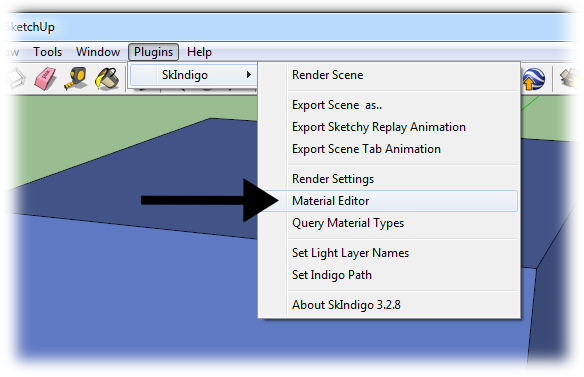
This opens the SkIndigo material editor window. At the top of the material editor window is a "Search" button, click this to open the material database window in SkIndigo:
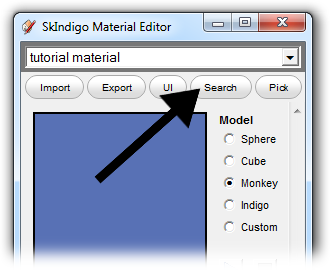
-
Downloading and applying a material
The material database browser window will open, allowing you to search for materials by keywords or name. By default the most recently materials submitted will appear at the top:

If we choose a material and double click it, SkIndigo will ask if you'd like to load it into the currently selected material; click "Yes", otherwise it will want to save the downloaded material to disk.
The downloaded material should now be loaded into the SketchUp material and applied to your object, ready for rendering with Indigo:

Alternative method: Linked IGM
It is however possible, that the material cannot be represented properly within SketchUp, since it is not a physically-based renderer. In such situations, SketchUp will present a warning dialog suggesting it be used as a "linked" material:
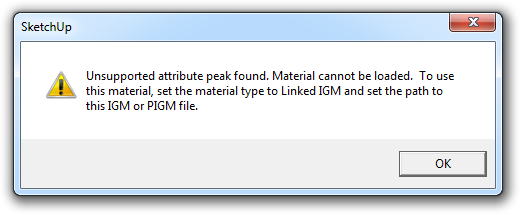
-
Linking a downloaded material
To do this, we select the material in the SkIndigo material editor, and set its Material Type to "Linked IGM":
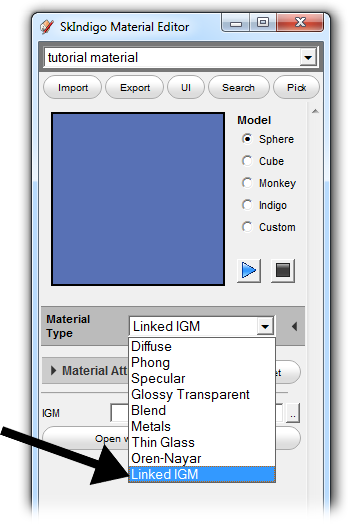
Click the ".." button next to the "IGM" field, and select a downloaded IGM or PIGM file. This will link the downloaded material to the SketchUp material so that when Indigo renders the scene, it will use the linked material.
Since the material cannot be represented correctly in SketchUp, SkIndigo will prompt you for a texture to use for the material in the SketchUp viewport. This is so you can easily identify the linked material, however it is optional:
